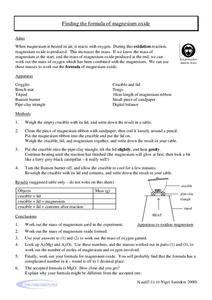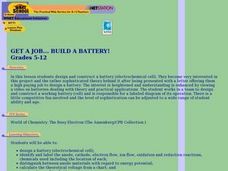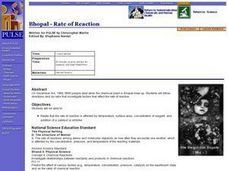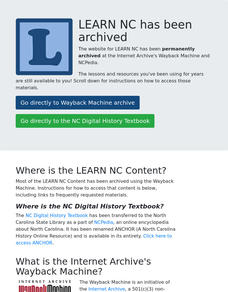Curated OER
Finding the Formula of Magnesium Oxide
Rather than simply matching up the ionic charges on paper, this exercise gets chemists into the lab to determine the chemical formula for magnesium oxide! If a know amount of magnesium is used, an oxidation reaction results in this...
Curated OER
Finding the Formula of Magnesium Oxide
In this formula for magnesium oxide worksheet, high schoolers perform an oxidation reaction between magnesium and the oxygen in the air to produce magnesium oxide. Using the known masses of the magnesium and the end product, students...
Curated OER
Factors Which Affect Corrosion
Young scholars investigate the factors which affect corrosion. In this corrosion lesson plan, students experiment with 2 nails, copper wire and magnesium ribbon placed in a petri dish of agar solution, potassium ferricyanate and an...
Curated OER
The Molar Volume of a Gas
Learners find the standard molar volume of a gas. In this molar volume of a gas lesson plan, students react magnesium metal and hydrochloric acid and collect the hydrogen gas produced using a gas collection tube. Learners calculate the...
Curated OER
Chemistry Lab-Molar Volume of Gas
Students determine the molar volume of hydrogen gas. In this molar volume lesson plan, students find the molar volume of hydrogen produced in a reaction between magnesium and hydrochloric acid. They use a eudiometer to measure the volume...
Curated OER
Heat of Formation using Hess's Law Lab
In this heat of formation learning exercise, students determine the heat of formation for magnesium by combining 3 given reactions and using Hess's Law. Students then complete a data calculations chart for each reaction.
Herff Jones Education
Reaction Rates
Equip pupils with tools to determine reaction rates as they explore conditions that cause a reaction to increase or decrease. They also discuss why this occurs and predict the next steps as they take part in a series of experiments.
Royal Society of Chemistry
Mass Changes in Chemical Reactions—Microscale Chemistry
What better way is there to introduce conservation of mass than a few simple experiments? Young chemists conduct two chemical reactions, take the masses of reactants and products, then compare their results to determine differences in...
Curated OER
5 Types of Chemical Reactions and a Lab on Mole
Young scholars recognize the concepts of the five general types of chemical reaction: combination, decomposition, single replacement, double replacement and combustion. They practice classifying chemical equations and determine the moles...
Curated OER
Physical and Chemical Changes
Students investigate chemical and physical changes. In this physical and chemical change lesson plan, students perform 3 experiments in the lab to observe changes in matter. They determine that no new substances are formed in physical...
Curated OER
How can pH be used to determine possible product tampering?
Students investigate the strength of acids and bases experimentally. They answer the question, "How can pH be used to determine possible product tampering?" by testing acids and bases with litmus paper.
Curated OER
Get a Job.....Build a Battery!
Students design and construct a battery (electrochemical cell). They works in a team to design and construct a working battery and is responsible for a labeled diagram of its operation. This engaging lesson stimulate their creative juices!
Curated OER
Bhopal - Rate of Reaction
Students determine that the rate of reaction is affected by temperature, surface area, concentration of reagent, and addition of a catalyst or inhibitor. They observe that on December 3rd, 1984, 8000 people died when the chemical plant...
Curated OER
Conversion Factors
In this conversion factor learning exercise, learners convert 15 problems within the SI system of measurement. They show their work and indicate the proper units.
Curated OER
Conversion Factors
In this conversion factors worksheet, students convert 15 measurements from one unit in the SI system of measurement to another unit. Students show their work and indicate the unit of measurement. Conversion factors are given.
Curated OER
Physical and Chemical Changes
Young scholars examine the different changes in matter. In this chemical change lesson plan students determine the amount of reactant made in a reaction using the law of conservation.
Curated OER
Types of Chemical Reactions
Students conduct labs to gain an overview of chemical reactions. They observe examples of synthesis, decomposition, single displacement and double displacement reactions. They identify certain products by the use of litmus and splint tests.
Curated OER
Types of Chemical Reactions
Students explore the different types of reactions and write the chemical equations for them. For this chemical lesson students identify different reactions and predict the product outcome.
Curated OER
Synthesis Reactions
Tenth graders write and balance chemical equations and make a PowerPoint presentation on synthesis reactions.
Curated OER
Don’t be a Stoic about Stoichiometry
Students review balancing chemical equations. In this chemistry lesson, students calculate moles of an unknown substance based on stoichiometric relationships in the balanced equation. They cite applications of stoichiometry in the real...





















